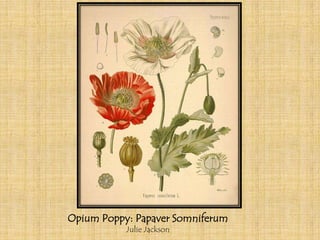
Opium
- 1. Opium Poppy: Papaver Somniferum Julie Jackson
- 2. •Opium (lachryma papaveris), is the dried latex obtained from the opium poppy, Papaver somniferum. Opium contains approximately 12% morphine, an alkaloid, which is frequently processed chemically to produce heroin for illegal drug trade. •The latex also includes codeine. •The traditional method of obtaining the latex is to scratch ("score") the immature seed pods (fruits) by hand; the latex leaks out and dries to a sticky yellowish residue that is later scraped off. The modern method is to harvest and process mature plants by machine. •Opium for illegal use is often converted into heroin, which is less bulky, making it easier to smuggle, which multiplies its potency to approximately twice that of morphine.
- 3. •Morphine is made from the opium poppy and latex is gathered from unripe poppy pods. •Another method of manufacturing morphine uses poppy straw from the dried stem and pods of the plant, then the crushed poppy plant is treated with sulphuric acid. The resulting mixture goes through numerous extraction processes. The final alkaloids are precipitated ammonium hydroxide or sodium carbonate. This further purifies morphine from other opium alkaloids.
- 4. •The origins of morphine can be traced back to 1522 when the scientist and alchemist Paracelsus is said to have used laudanum, as a pain killer. •The popularity of laudanum increased with the East India Company’s interest in opium trade in 1757 and was eventually marketed as a drug to cure alcohol and opium addiction. It was only later that they realized that morphine could be equally addictive. • The drug was extensively used during the American Civil War. http://thisiswarblog.wordpress.com/201 2/09/23/stoned-in-the-ranks-drug- and-alcohol-abuse-nothing-new-in- military-culture/ •An important factor in the adoption of morphine as a pain killer, was the invention of the hypodermic needle in 1853.
- 5. •Morphine can be used to treat a number of ailments: •Patients suffering from heart attacks, •Pain associated with surgery, trauma and chronic pain like cancer. •It is used as general anesthesia, a substance that puts you to sleep if you need to have a surgery, so that you don’t remember it.
- 6. •Morphine’s primary clinical use is to manage moderately severe and severe pain. •After heroin, morphine has the greatest dependence liability of the narcotic analgesics in common use. •Morphine is administered by several routes (injected, smoked, sniffed, or swallowed); but when injected particularly intravenously, morphine can produce intense euphoria and a general state of well-being and relaxation. •Regular use can result in the rapid development of tolerance to these effects. •Profound physical and psychological dependence can also rapidly develop, and withdrawal sickness upon abrupt cessation of heroin use; many of the symptoms resemble those produced by a case of moderately severe flu.
- 7. •Street names of morphine include M, 13, Emma, cube, morf, mofo, dry grog, white hop, uncle, coby, gold dust, love dust, monkey dust, and many more. • Morphine is marketed under several brand names like oxycodone (Percodan), dihydromorphenone (Dilaudid), and hydrocodone (Vicodin). and many other brand names. •Morphine occurs as feathery, white, and silky crystals; cubical crystal masses; or white powdered crystal and dissolves in water and slightly in alcohol.
- 8. •Heroin was first synthesized by C.R. Alder Wright in 1874 by adding two acetyl groups to the morphine molecule. •When used in medicine it is typically used to treat severe pain, such as that resulting from a heart attack or a severe injury. •The name "heroin" is only used when being discussed in its illegal form. •When it is used in a medical environment, it is referred to as Diamorphine and comes in tablet or injectable form for the same indications as morphine and is often being preferred over morphine due to its lower side- effect profile
- 9. •The only significant difference between Morphine and Heroin is that the acetyl molecule allows heroin to cross the blood-brain barrier more quickly than ordinary morphine. •In terms of dosage, heroin is about three times stronger. •One grain of heroin equals about three Heroin Morphine grains of morphine. Otherwise, they are identical and there is no significant difference that would justify heroin being completely illegal (Schedule I) while morphine is used routinely in medicine. (Schedule II). • They can be used interchangeably as long as medical personnel follow standard practices of medical care.